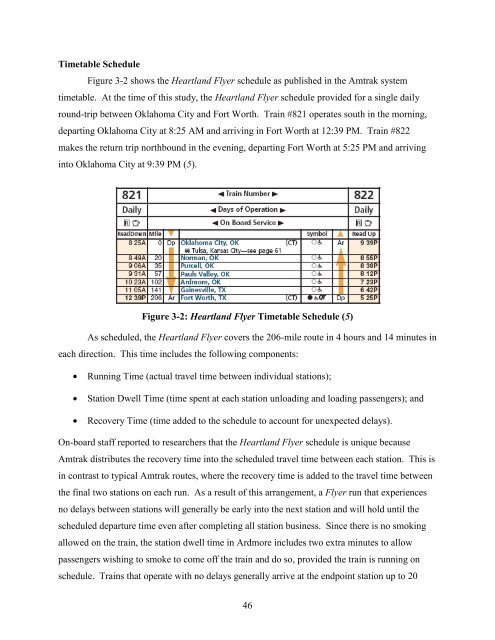Measuring the Benefits of Intercity Passenger Rail: A Study
Measuring the Benefits of Intercity Passenger Rail: A Study
Measuring the Benefits of Intercity Passenger Rail: A Study
Create successful ePaper yourself
Turn your PDF publications into a flip-book with our unique Google optimized e-Paper software.
Timetable Schedule<br />
Figure 3-2 shows <strong>the</strong> Heartland Flyer schedule as published in <strong>the</strong> Amtrak system<br />
timetable. At <strong>the</strong> time <strong>of</strong> this study, <strong>the</strong> Heartland Flyer schedule provided for a single daily<br />
round-trip between Oklahoma City and Fort Worth. Train #821 operates south in <strong>the</strong> morning,<br />
departing Oklahoma City at 8:25 AM and arriving in Fort Worth at 12:39 PM. Train #822<br />
makes <strong>the</strong> return trip northbound in <strong>the</strong> evening, departing Fort Worth at 5:25 PM and arriving<br />
into Oklahoma City at 9:39 PM (5).<br />
Figure 3-2: Heartland Flyer Timetable Schedule (5)<br />
As scheduled, <strong>the</strong> Heartland Flyer covers <strong>the</strong> 206-mile route in 4 hours and 14 minutes in<br />
each direction. This time includes <strong>the</strong> following components:<br />
• Running Time (actual travel time between individual stations);<br />
• Station Dwell Time (time spent at each station unloading and loading passengers); and<br />
• Recovery Time (time added to <strong>the</strong> schedule to account for unexpected delays).<br />
On-board staff reported to researchers that <strong>the</strong> Heartland Flyer schedule is unique because<br />
Amtrak distributes <strong>the</strong> recovery time into <strong>the</strong> scheduled travel time between each station. This is<br />
in contrast to typical Amtrak routes, where <strong>the</strong> recovery time is added to <strong>the</strong> travel time between<br />
<strong>the</strong> final two stations on each run. As a result <strong>of</strong> this arrangement, a Flyer run that experiences<br />
no delays between stations will generally be early into <strong>the</strong> next station and will hold until <strong>the</strong><br />
scheduled departure time even after completing all station business. Since <strong>the</strong>re is no smoking<br />
allowed on <strong>the</strong> train, <strong>the</strong> station dwell time in Ardmore includes two extra minutes to allow<br />
passengers wishing to smoke to come <strong>of</strong>f <strong>the</strong> train and do so, provided <strong>the</strong> train is running on<br />
schedule. Trains that operate with no delays generally arrive at <strong>the</strong> endpoint station up to 20<br />
46
















